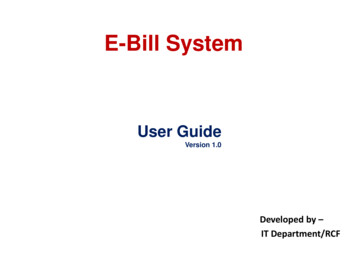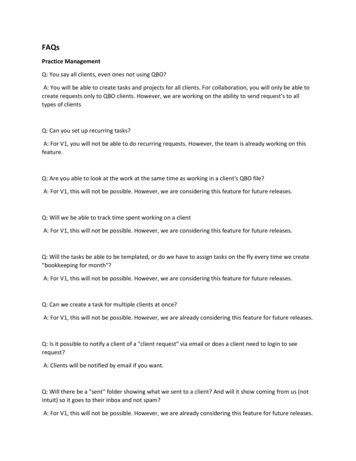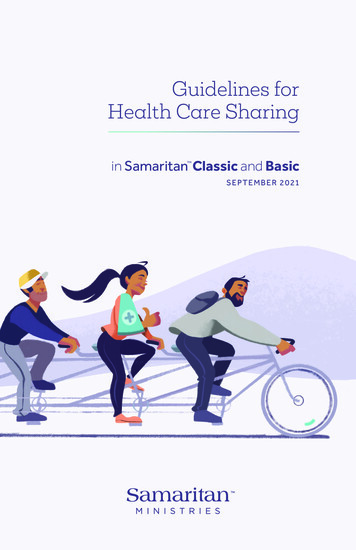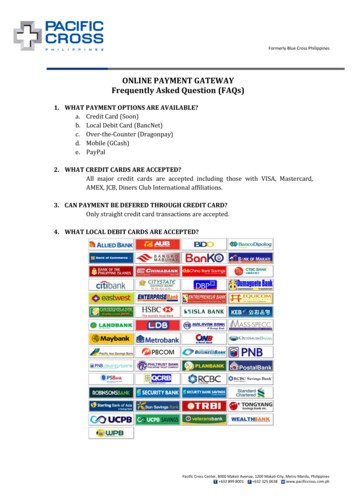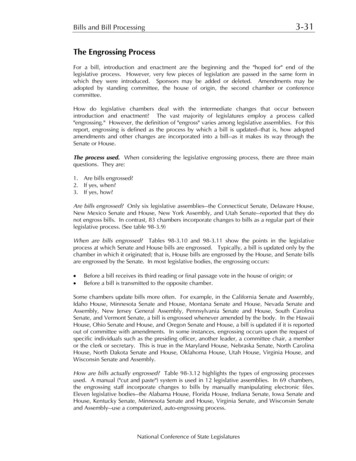
Transcription
Bills and Bill Processing3-31The Engrossing ProcessFor a bill, introduction and enactment are the beginning and the "hoped for" end of thelegislative process. However, very few pieces of legislation are passed in the same form inwhich they were introduced. Sponsors may be added or deleted. Amendments may beadopted by standing committee, the house of origin, the second chamber or conferencecommittee.How do legislative chambers deal with the intermediate changes that occur betweenintroduction and enactment? The vast majority of legislatures employ a process called"engrossing." However, the definition of "engross" varies among legislative assemblies. For thisreport, engrossing is defined as the process by which a bill is updated--that is, how adoptedamendments and other changes are incorporated into a bill--as it makes its way through theSenate or House.The process used. When considering the legislative engrossing process, there are three mainquestions. They are:1. Are bills engrossed?2. If yes, when?3. If yes, how?Are bills engrossed? Only six legislative assemblies--the Connecticut Senate, Delaware House,New Mexico Senate and House, New York Assembly, and Utah Senate--reported that they donot engross bills. In contrast, 83 chambers incorporate changes to bills as a regular part of theirlegislative process. (See table 98-3.9)When are bills engrossed? Tables 98-3.10 and 98-3.11 show the points in the legislativeprocess at which Senate and House bills are engrossed. Typically, a bill is updated only by thechamber in which it originated; that is, House bills are engrossed by the House, and Senate billsare engrossed by the Senate. In most legislative bodies, the engrossing occurs: Before a bill receives its third reading or final passage vote in the house of origin; orBefore a bill is transmitted to the opposite chamber.Some chambers update bills more often. For example, in the California Senate and Assembly,Idaho House, Minnesota Senate and House, Montana Senate and House, Nevada Senate andAssembly, New Jersey General Assembly, Pennsylvania Senate and House, South CarolinaSenate, and Vermont Senate, a bill is engrossed whenever amended by the body. In the HawaiiHouse, Ohio Senate and House, and Oregon Senate and House, a bill is updated if it is reportedout of committee with amendments. In some instances, engrossing occurs upon the request ofspecific individuals such as the presiding officer, another leader, a committee chair, a memberor the clerk or secretary. This is true in the Maryland House, Nebraska Senate, North CarolinaHouse, North Dakota Senate and House, Oklahoma House, Utah House, Virginia House, andWisconsin Senate and Assembly.How are bills actually engrossed? Table 98-3.12 highlights the types of engrossing processesused. A manual ("cut and paste") system is used in 12 legislative assemblies. In 69 chambers,the engrossing staff incorporate changes to bills by manually manipulating electronic files.Eleven legislative bodies--the Alabama House, Florida House, Indiana Senate, Iowa Senate andHouse, Kentucky Senate, Minnesota Senate and House, Virginia Senate, and Wisconsin Senateand Assembly--use a computerized, auto-engrossing process.National Conference of State Legislatures
3-32Inside the Legislative ProcessWhen a bill is engrossed, most chambers differentiate the newest version from the original orother renditions. Table 98-3.13 illustrates the various ways by which legislative bodies indicatethe differences. Frequently, the physical appearance of the versions varies. Forty-two chambersstamp "engrossed" on the printed bill. In 22 legislative assemblies, the bill number on printedcopies has an engrossment indicator added. For example, HB 24-2ndE indicates the secondengrossment of House Bill 24. The Florida Senate, Indiana House, Montana Senate and House,North Carolina House, and Utah House use color-coding systemsJust as printed copies of engrossed bills differ, so do the computerized versions. Eighteenchambers add engrossment indicators to electronic bill versions. It is common for the computerfile for each engrossment to be given a new name or number. This is true in 38 legislativebodies.Correcting errors. The process of engrossing a bill is very exacting. The staff often deal withvery complex or conflicting amendments and limited time frames. As a result, errors sometimesoccur. The engrossing staffs in 64 chambers are allowed to fix minor grammatical or spellingerrors (see table 98-3.14). However, the correction of substantive engrossing errors usuallyrequires legislative action, such as the adoption of an amendment or passage of a resolution.The Illinois Senate and House recall the bill from third reading and final passage and return it tosecond reading for amendment. In the Oregon Senate and House, the bill is returned tocommittee for correction. The Puerto Rico Senate may reconsider the bill on the next sessionday.Unofficial engrossments. Typically, when a bill is engrossed, a new, official version is created.Sometimes, however, a committee or a member "just wants to see what it'll look like" ifnumerous or complex amendments are added to a bill. In these instances, an "unofficialengrossment" may be requested.Not all chambers allow the creation of unofficial engrossments (see table 98-3.15). In fact, 47legislative bodies reported that these documents are not used. Thirty-five legislative chambersreported that they use unofficial engrossments, but variety exists in the extent to which thesedocuments occur. In 20 chambers, unofficial engrossments are rare. The Colorado House,Kansas Senate, Michigan House, Minnesota Senate and House and Vermont Senate and Housefall at the other end of the spectrum, and the "what it looks like" renditions are very common.The majority of chambers that allow unofficial engrossments do not have formal processes bywhich to request them. Only 13 legislative assemblies reported set procedures. For example, inthe Maryland Senate and House, South Dakota Senate and House, and Tennessee Senate, thepresident or speaker must approve a request for an unofficial engrossment. The requests aremade to the clerk in the Louisiana House and Oregon House, to the engrossing clerk or Senatecounsel in the Minnesota Senate, and to the parliamentarian in the Pennsylvania House. In theKansas Senate, the revisor's office provides unofficial engrossments at the request of acommittee chair or legislator. An unofficial engrossment is created automatically if a bill isamended and held over for further discussion in the Alaska House and Colorado Senate. InNebraska, a member's request for a "white copy" must be approved by unanimous consent onthe floor.Staffing. Who is responsible for engrossing bills? Most frequently, the work is assigned to theclerk's office or to a central, nonpartisan staff agency (see table 98-3.17). The engrossing staffare part of the clerk's office in 47 chambers and part of a central staff agency in 32 legislativebodies. Table 98-3.18 indicates the number of people employed by legislative bodies toperform this function during session and during the interim.National Conference of State Legislatures
Bills and Bill ProcessingNational Conference of State Legislatures3-33
3-34Inside the Legislative ProcessTable 98-3.9 Which Chambers Engross Bills?The following chambers engross bills:Alabama Senate and HouseAlaska Senate and HouseArizona Senate and HouseArkansas SenateCalifornia Senate and AssemblyColorado Senate and HouseFlorida Senate and HouseGeorgia Senate and HouseHawaii Senate and HouseIdaho Senate and HouseIllinois Senate and HouseIndiana Senate and HouseIowa Senate and HouseKansas Senate and HouseKentucky Senate and HouseLouisiana Senate and HouseMaine HouseMaryland Senate and HouseMassachusetts Senate and HouseMichigan Senate and HouseMinnesota Senate and HouseMississippi Senate and HouseMissouri SenateThe following chambers do not engross bills:Connecticut SenateDelaware HouseNew Mexico Senate and HouseMontana Senate and HouseNebraska SenateNevada Senate and AssemblyNew Jersey Senate and General AssemblyNorth Carolina HouseNorth Dakota Senate and HouseOhio Senate and HouseOklahoma Senate and HouseOregon Senate and HousePennsylvania Senate and HouseRhode Island HouseSouth Carolina Senate and HouseSouth Dakota Senate and HouseTennessee Senate and HouseTexas Senate and HouseUtah HouseVermont Senate and HouseVirginia Senate and HouseWashington SenateWest Virginia Senate and HouseWisconsin Senate and AssemblyWyoming Senate and HousePuerto Rico SenateNew York AssemblyUtah SenateNational Conference of State Legislatures
Bills and Bill Processing3-35Table 98-3.10 When the Senate Engrosses Senate BillsState tanaDescriptionBefore being transmitted to the House if committee or flooramendments are adopted by the SenateAfter final passage but prior to transmittal to the HousePrior to the third reading or final passage votePrior to the third reading or final passage votePrior to each reading of the bill; whenever amended in the SenateAfter second and third readingPrior to the third reading or final passage vote in the SenateAfter final passage but prior to transmittal to the HousePrior to each reading of the billWhen amended in the Senate; after Senate concurs with HouseamendmentsPrior to the third reading or final passage vote in the SenatePrior to the third reading or final passage vote in the SenateAfter final passage but prior to transmittal to the HouseAfter final passage but prior to transmittal to the House; after Senateconcurs with House amendments; after a conference committeereport is adopted by both chambersAfter final passage but prior to transmittal to the House; after theSenate concurs with House amendments; after a conferencecommittee report is adoptedPrior to the third reading or final passage vote in the SenatePrior to the third reading or final passage vote; after final passagebut prior to transmittal to the HouseAfter three readings in the SenateAfter general orders; after third reading but prior to transmittal tothe other chamberWhenever amendments are adopted by action of the entire SenateAfter final passage but prior to transmittal to the HouseIf reported as a committee substitute; prior to the third reading orfinal passage vote in the SenateIf amended by standing committee, committee of the whole(second reading), conference committee or governor's amendatoryvetoNational Conference of State Legislatures
3-36Inside the Legislative ProcessTable 98-3.10 When the Senate Engrosses Senate Bills, cont’d.State (1)NebraskaNevadaNew HampshireNew JerseyNew MexicoNew YorkNorth CarolinaNorth DakotaOhioOklahomaOregonPennsylvaniaRhode IslandSouth CarolinaSouth est VirginiaWisconsinWyomingPuerto RicoDescriptionPrior to each reading of the bill; prior to the third reading or finalpassage vote; whenever amendments are adopted. However,unless a request by a member is adopted by unanimous consent,engrossed copies are not provided until prior to third reading.Whenever amendedPrior to each reading of the billPrior to each reading of the billPrior to the third reading or final passage vote; after passageUpon introduction; when reported from committee; after thirdreading; when the Senate concurs to House amendments; after aconference committee report is acceptedIf requested by a committee when amendments are so complexthat engrossing would make the bill easier to read; when amendedby one committee and sent to another committee; prior to the thirdreading or final passage vote in the SenateWhenever a bill is amendedWhenever the bill is amendedPrior to each reading of the billAfter final passage but prior to transmittal to the HouseAfter final passage but prior to transmittal to the HouseWhenever an amendment is adopted; prior to the third reading orfinal passage vote in the Senate; after final passage but prior totransmittal to the HousePrior to the third reading or final passage vote in the SenateAfter final passage but prior to transmittal to the HousePrior to the third reading or final passage vote in the SenateAt the request of an author, member, committee chair, bill drafteror chief clerk; after passage or upon receipt from the AssemblyAfter final passage but prior to transmittal to the HouseAfter final passage but prior to transmittal to the HouseNote:1. The following chambers did not return a survey: Arkansas House, Connecticut House,Delaware Senate, Maine Senate, Missouri House, New Hampshire Senate and House, NewYork Senate, North Carolina Senate, Rhode Island Senate, Washington House, AmericanSamoa Senate and House, District of Columbia Council, Guam Senate, Northern MarianaIslands Senate and House, Puerto Rico House and Virgin Islands Senate.National Conference of State Legislatures
Bills and Bill Processing3-37Table 98-3.11 When the House Engrosses House BillsState tanaNebraskaNevadaNew HampshireNew JerseyDescriptionAfter final passage but prior to transmittal to the SenateAfter final passage but prior to transmittal to the SenatePrior to the third reading or final passage vote in each chamberPrior to each reading of the billPrior to second reading, third reading and transmittal to the SenateAfter second and third reading if amended in House; after theHouse concurs in Senate amendment(s) to House billAfter final passage but prior to transmittal to the SenateWhenever an amended bill is reported out of committeeWhenever an amendment is adoptedPrior to second reading, when possible; otherwise, prior to thirdreadingWhen reported to the floor by a committee; after second reading,but bills are not physically reprinted unless amendedAfter final passage but prior to transmittal to the SenatePrior to the third reading or final passage vote; after the Houseconcurs in Senate amendments or a conference committee report ispassed by both housesIf amended, prior to transmittal to the Senate; after final passage inboth chambersIf reported with amendments by committee; after final passage ifthere are floor amendmentsWhen given two readings in concurrence in each chamberPrior to the third reading or final passage vote; at direction ofspeaker; at direction of clerk due to printing or typographical errorsAfter the three readings in the HousePrior to the third reading or final passage vote; after final passagebut prior to transmittal to the SenateWhenever amendments are adopted by the HouseAfter final passage but prior to transmittal to the SenateWhenever amended by standing committee, committee of thewhole (second reading) conference committee or governor'samendatory vetoWhenever amendedWhenever amendedNational Conference of State Legislatures
3-38Inside the Legislative ProcessTable 98-3.11 When the House Engrosses House Bills, cont’d.State (1)New MexicoNew YorkNorth CarolinaNorth DakotaOhioOklahomaOregonPennsylvaniaRhode IslandSouth CarolinaSouth est VirginiaWisconsinWyomingPuerto RicoDescriptionPrior to re-referral of the bill to another committee; when requestedby the presiding officer; when requested by a standing committee;after final passage but prior to transmittal to the SenatePrior to each reading of the billUpon introduction; when reported by committee; after thirdconsideration (reading) floor vote; when the House concurs withSenate amendments; when a conference report is acceptedPrior to the third reading or final passage vote; after final passagebut prior to transmittal to the Senate; when requested by a memberWhenever a bill is reported out of committee with amendment(s)Whenever the bill is amended and voted uponWhenever requested by a memberIf the House adopts a committee amendment; on second reading;on third reading with unanimous consentPrior to each reading of the billAfter final passage but prior to transmittal to the SenatePrior to third reading, but this version is not available for generaldistribution; after final passage but prior to transmittal to the SenateAfter final passage but prior to transmittal to the Senate; wheneverrequested by the presiding officer; whenever requested by therules, calendar or another management committee; wheneverrequested by a memberPrior to each reading of the billPrior to the third reading or final passage vote; whenever requestedby the presiding officerPrior to the third reading or final passage voteAfter final passage but prior to transmittal to the Senate; whenrequested by the chief clerkAfter final passage but prior to transmittal to the SenateNote:1. The following chambers did not return a survey: Arkansas House, Connecticut House,Delaware Senate, Maine Senate, Missouri House, New Hampshire Senate and House, NewYork Senate, North Carolina Senate, Rhode Island Senate, Washington House, AmericanSamoa Senate and House, District of Columbia Council, Guam Senate, Northern MarianaIslands Senate and House, Puerto Rico House and Virgin Islands Senate.National Conference of State Legislatures
3-39Bills and Bill ouriMontanaBSHSBSBBHHBBBHBBSOtherengrossing process is usedA computerized, auto-BBBSHBHBincorporate changescomputer files of bills toStaff manually manipulate(i.e., cut and paste)State (1)The process is totally manualTable 98-3.12 Type of Engrossing Process UsedSBSBBSBNational Conference of State Legislatures
3-40Inside the Legislative ProcessNebraskaNevadaNew HampshireNew JerseyNew MexicoNew YorkNorth CarolinaNorth DakotaOhioOklahomaOregonPennsylvaniaRhode IslandSouth CarolinaSouth est VirginiaWisconsinWyomingPuerto RicoOtherengrossing process is usedA computerized, auto-incorporate changescomputer files of bills toStaff manually manipulate(i.e., cut and paste)State (1)The process is totally manualTable 98-3.12 Type of Engrossing Process Used, cont’d.SSBSHBHHHBBBBBBBSBHBHSB2SBBSNational Conference of State Legislatures
Bills and Bill Processing3-41Table 98-3.12 Type of Engrossing Process Used, cont’d.Key:S SenateH House or AssemblyB Both chambersNotes:1. The following chambers did not return a survey: Arkansas House, Connecticut House,Delaware Senate, Maine Senate, Missouri House, New Hampshire Senate and House, NewYork Senate, North Carolina Senate, Rhode Island Senate, Washington House, AmericanSamoa Senate and House, District of Columbia Council, Guam Senate, Northern MarianaIslands Senate and House, Puerto Rico House and Virgin Islands Senate.2. Vermont Senate: Some changes are done by typewriter (with a colored ribbon). These areusually small changes.National Conference of State Legislatures
State tanaSBHSHBB2BBHBBSSBBSBHBHBBBBBHBBBBHSBHBNational Conference of State LegislaturesSSBSSHBHSSOtherassigned a new numberengrossment of a bill isThe computer file for eachassigned a new nameengrossment of a bill isThe computer file for eachto computerized copiesengrossment indicator addedThe bill number has anto printed copiesengrossment indicator addedThe bill number has anstamped "engrossed"The printed, engrossed bill isintroduced versionengrossed bill differs fromThe physical appearance of an3-42Inside the Legislative ProcessTable 98-3.13 Differentiation among Bill VersionsB3BS4BH56H7891011
3-43Bills and Bill ProcessingNebraskaNevadaNew HampshireNew JerseyNew MexicoNew YorkNorth CarolinaNorth DakotaOhioOklahomaOregonPennsylvaniaRhode IslandSouth CarolinaSouth est VirginiaWisconsinWyomingPuerto d a new numberengrossment of a bill isThe computer file for eachassigned a new nameengrossment of a bill isThe computer file for eachto computerized copiesengrossment indicator addedThe bill number has anto printed copiesengrossment indicator addedThe bill number has anstamped "engrossed"The printed, engrossed bill isintroduced versionengrossed bill differs fromState (1)The physical appearance of anTable 98-3.13 Differentiation among Bill Versions, cont’d.HBSHSHHHBBBH1617BSBBBBSSNational Conference of State LegislaturesHSBBBS
3-44Inside the Legislative ProcessTable 98-3.13 Differentiation among Bill Versions, cont’d.Key:S SenateH House or AssemblyB Both chambersNotes:1. The following chambers did not return a survey: Arkansas House, Connecticut House,Delaware Senate, Maine Senate, Missouri House, New Hampshire Senate and House, NewYork Senate, North Carolina Senate, Rhode Island Senate, Washington House, AmericanSamoa Senate and House, District of Columbia Council, Guam Senate, Northern MarianaIslands Senate and House, Puerto Rico House and Virgin Islands Senate.2. Alaska Senate and House: The computer file for each new version of a bill that is offered isassigned a new bill name.3. Arkansas Senate: The engrossment date also is added.4. Florida Senate: The colors of bill jackets change according to stage in process--fromintroduction to final engrossment.5. Indiana House: The printing date is placed on the bill. Reprints awaiting a third readingvote are printed on yellow paper.6. Kentucky Senate: Special designators are used. For example, a bill as introduced shows "InSenate;" as passed by one chamber, "General Assembly;" and as enrolled, "EN" designation.7. Massachusetts Senate and House: Generally, when a bill receives major changes, it isincorporated into a new draft, assigned a new bill number and printed as a new document.8. Michigan Senate: The date of update is shown on the first page of the document. There isa date header on each amended page with Senate amendments denoted with redlining orshading and House amendments denoted with brackets [ ].9. Mississippi House: The bill number is not changed; however, the bill's request number ismodified to reflect where the bill was changed.10. Missouri Senate: Printed bills have a title to indicate the version.11. Montana Senate and House: Different versions of bill are printed on unique colors ofpaper.12. Nevada Assembly: “First reprint,” “Second reprint,” etc. is printed on the face of the bill.13. North Carolina House: Different versions of Senate bills are printed on different colors ofpaper, including House committee substitutes.14. Ohio Senate and House: The version is indicated on the top of the first page--for example,"as reported by committee" or "as passed by the Senate."15. Pennsylvania Senate and House: A new printer's number is assigned to each new versionof a bill.16. South Carolina Senate and House: A legend, created on the front or cover page of eachbill, contains the action language and the date of the action.17. Utah House: A color coding system is used; lilac is used for the House and goldenrod forthe Senate.National Conference of State Legislatures
3-45Bills and Bill Otherpassed by both chamberscorrected by a resolutionSubstantive errors arecorrected by amendmentSubstantive errors areand reissue a new versionengrossment, correct the errorEngrossing staff recall theadopted amendmentstatutory text omitted from anEngrossig staff may addcitation errorsEngrossing staff may correctspelling errorsEngrossing staff may correctminor grammatical errorsState (1)Engrossing staff may correctTable 98-3.14 Process Used to Correct Engrossing BSBNational Conference of State LegislaturesB
3-46Inside the Legislative ProcessNebraskaNevadaNew HampshireNew JerseyNew MexicoNew YorkNorth CarolinaNorth DakotaOhioOklahomaOregonPennsylvaniaRhode IslandSouth CarolinaSouth est VirginiaWisconsinWyomingPuerto HBSBHSHHSBBNational Conference of State LegislaturesOther8SBSBSSpassed by both chamberscorrected by a resolutionSubstantive errors arecorrected by amendmentSubstantive errors areand reissue a new versionengrossment, correct the errorEngrossing staff recall theadopted amendmentstatutory text omitted from anEngrossig staff may addcitation errorsEngrossing staff may correctspelling errorsEngrossing staff may correctminor grammatical errorsState (1)Engrossing staff may correctTable 98-3.14 Process Used to Correct Engrossing Errors, cont’d.9HBBHBBHHBBBHBBSBBBS1011S1213H14S15
Bills and Bill Processing3-47Table 98-3.14 Process Used to Correct Engrossing Errors, cont’d.Key:S SenateH House or AssemblyB Both chambersNotes:1. The following chambers did not return a survey: Arkansas House, Connecticut House,Delaware Senate, Maine Senate, Missouri House, New Hampshire Senate and House, NewYork Senate, North Carolina Senate, Rhode Island Senate, Washington House, AmericanSamoa Senate and House, District of Columbia Council, Guam Senate, Northern MarianaIslands Senate and House, Puerto Rico House and Virgin Islands Senate.2. California Senate: Bill authors are notified.3. Colorado House: By a correction schedule or message from the revisor (drafting in statuteconflicts) or in conference committee.4. Indiana Senate and House: According to the Senate, Joint Rule 20 addresses certaincorrections. In the House, printers' errors are corrected upon the order of the clerk orcounsel to the Speaker.5. Kansas Senate: By Senate rule, the secretary is allowed to correct spelling errors,punctuation and "doublets" or repeated words.6. Maryland House: All error correction must be approved by the chief clerk.7. Mississippi House: Substantive error in House bills may be corrected by unanimousconsent of the House; errors in conference reports may be corrected by unanimous consentby both the House and Senate.8. Nevada Assembly: Changes to a bill may be necessary due to its conflict with other passedlegislation. If time permits, either an amendment or another bill is drafted and acted uponby the legislature. Otherwise, the error is corrected the following session.9. New Jersey House: The bill processing unit notifies the person who drafted the bill.10. North Carolina House: Minor spelling errors can be corrected if initialed by the chair ofthe House Committee on Rules, Calendar and Operations, the principal clerk or thelegislative services officer. All other corrections must be made by amendment to the bill.11. Ohio Senate: The bill may be reconsidered if "wrong" amendment was adopted.12. Oregon Senate and House: If an error is discovered on the floor during third reading andfinal passage, the bill is sent back to committee for correction.13. Pennsylvania House: The parliamentarian may authorize a "corrective reprint."14. South Carolina Senate: The clerk has the authority to correct most errors.15. Puerto Rico Senate: If a substantive error is discovered, the bill may be reconsidered duringthe next day's session.National Conference of State Legislatures
3-48Inside the Legislative ProcessTable 98-3.15 Use of Unofficial EngrossmentsThe following chambers do not use unofficial engrossmentsAlabama Senate and HouseNew Jersey Senate and General AssemblyAlaska SenateNew Mexico SenateArizona Senate and HouseNew York AssemblyCalifornia Senate and AssemblyNorth Carolina HouseConnecticut SenateNorth Dakota Senate and HouseFlorida Senate and HouseOhio Senate and HouseGeorgia Senate and HouseOklahoma SenateHawaii SenateOregon SenateIllinois Senate and HousePennsylvania SenateIndiana SenateRhode Island HouseIowa SenateSouth Carolina SenateKansas HouseUtah Senate and HouseKentucky HouseVirginia Senate and HouseMaine HouseWashington SenateMassachusetts Senate and HouseWest Virginia SenateMississippi Senate and HouseWisconsin Senate and AssemblyMissouri SenateWyoming Senate and HouseNevada Senate and AssemblyThe following chambers very rarely use unofficial engrossmentsArkansas SenateNebraska SenateColorado SenateNew Mexico HouseDelaware HouseOklahoma HouseIndiana HouseOregon HouseIowa HousePennsylvania HouseKentucky SenateSouth Dakota Senate and HouseMaryland HouseTennessee Senate and HouseMichigan SenateTexas Senate and HouseMontana Senate and HouseNational Conference of State Legislatures
Bills and Bill ProcessingTable 98-3.15 Use of Unofficial Engrossments, cont’d.The following chambers occasionally use unofficial engrossmentsAlaska HouseMaryland SenateIdaho Senate and HouseSouth Carolina HouseLouisiana Senate and HousePuerto Rico SenateMaryland SenateThe following chambers frequently use unofficial engrossmentsColorado HouseMinnesota Senate and HouseKansas SenateVermont Senate and HouseMichigan HouseNational Conference of State Legislatures3-49
3-50Inside the Legislative tional Conference of State Legislaturesdrafting or research officeeither the Senate or HouseEngrossing staff are part ofagencyof a central, nonpartisan staffEngrossing personnel are partclerk's office in each chamberEngrossing staff are part
Before a bill receives its third reading or final passage vote in the house of origin; or Before a bill is transmitted to the opposite chamber. Some chambers update bills more often. For example, in the California Senate and Assembly, Idaho House, Minnesota Senate and House, Montana Senate and House, Nevada Senate and
